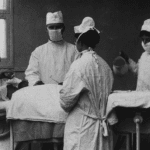 Animals
Animals  Animals
Animals  Health
Health 10 Medical Treatments Your Doctor Probably Won’t Approve
 Humans
Humans 10 Fascinating Beliefs of Indigenous Cultures
 Movies and TV
Movies and TV 10 Major Movies That Filmed Without a Script
 Weird Stuff
Weird Stuff The Crazy Stories Behind 10 Legendary Spite Houses
 Mysteries
Mysteries 10 Puzzling Disappearances at Zion National Park
 Facts
Facts Top 10 Cool Facts about 7-Eleven
 History
History 10 Merciless Monarch Murders You May Not Know About
 Animals
Animals 10 Heartwarming (Scientific) Stories about Cats
 Music
Music Ten Singers Who Absolutely Detest One of Their Hit Songs
 Animals
Animals 10 Animal Actions You’ve Never Seen (Caught on Camera)
 Health
Health 10 Medical Treatments Your Doctor Probably Won’t Approve
 Humans
Humans 10 Fascinating Beliefs of Indigenous Cultures
Who's Behind Listverse?

Jamie Frater
Head Editor
Jamie founded Listverse due to an insatiable desire to share fascinating, obscure, and bizarre facts. He has been a guest speaker on numerous national radio and television stations and is a five time published author.
More About Us Movies and TV
Movies and TV 10 Major Movies That Filmed Without a Script
 Weird Stuff
Weird Stuff The Crazy Stories Behind 10 Legendary Spite Houses
 Mysteries
Mysteries 10 Puzzling Disappearances at Zion National Park
 Facts
Facts Top 10 Cool Facts about 7-Eleven
 History
History 10 Merciless Monarch Murders You May Not Know About
 Animals
Animals 10 Heartwarming (Scientific) Stories about Cats
 Music
Music Ten Singers Who Absolutely Detest One of Their Hit Songs
10 Medical Treatments Your Doctor Probably Won’t Approve
Most people trust their doctors to provide the best possible care when it comes to medical treatments. However, there exists a world of unconventional and controversial therapies that, despite their bizarre nature, continue to attract attention and debate. These treatments often come with bold claims and a following of devoted practitioners, yet they remain outside the bounds of mainstream medicine for various reasons. Whether due to lack of scientific evidence, potential harm, or just plain absurdity, these treatments are ones your doctor is likely to frown upon.
Some of these methods have roots in traditional medicine, while others have emerged from the fringes of the health and wellness community. Regardless of their origins, they share a common thread: Mainstream medical professionals typically advise against them. This is not just because these treatments are unconventional but because many lack the rigorous testing and proven benefits that are hallmarks of effective medical care.
In this list, we explore ten medical treatments that your doctor probably won’t approve of. These are not just quirky health tips or harmless home remedies; they are practices that can be risky, controversial, and sometimes downright dangerous. Buckle up as we delve into the strange and sometimes shocking world of medical treatments you won’t find in your doctor’s office.
Related: 10 Medical Miracles Doctors Still Can’t Explain
10 Drinking Your Own Urine: The Ultimate DIY Health Hack
The practice of drinking one’s own urine, also known as urine therapy, has a long history and has been promoted by some as a natural remedy for a wide array of ailments, from infections to cancer. Advocates claim urine contains valuable nutrients and antibodies to boost the immune system and detoxify the body. Despite these bold claims, medical professionals warn that there is no scientific evidence to support the health benefits of drinking urine. In fact, consuming urine can lead to the ingestion of waste products and toxins that the body has already expelled, posing serious health risks.
While some cultures and alternative medicine enthusiasts continue to promote urine therapy as a cure-all, it remains a highly controversial and largely discredited practice in the medical community. The human body has an efficient system for filtering out waste products through the kidneys, and urine is essentially a vehicle for removing these wastes. Reintroducing them into the body by drinking urine can potentially lead to kidney damage, infections, and other health complications. It’s a health hack that your doctor is almost certain to advise against.[1]
9 Leech Therapy: Bloodsucking Parasites for Modern Healing
Leech therapy, or hirudotherapy, may sound like a medieval relic, but it continues to find a place in modern alternative medicine. Proponents claim that leeches can be used to treat a variety of conditions, including arthritis, migraines, and even cardiovascular diseases. The therapy involves placing live leeches on the skin, where they attach and draw blood.
The leeches’ saliva contains anticoagulants and enzymes that are believed to enhance blood circulation and promote healing. Despite these claims, the practice remains controversial. It is often met with skepticism from the medical community due to the risks of infection and the availability of more effective treatments.
While leech therapy has historical roots dating back to ancient Egypt and Greece, its resurgence in the modern era is largely confined to niche circles and specific medical conditions. The FDA has approved leeches for limited use in reconstructive surgery to help restore blood flow to damaged tissues.
Still, healthcare professionals do not endorse their use outside of these contexts. The potential for allergic reactions and bacterial infections makes leech therapy a treatment that most doctors would advise against, especially given the advances in safer, more reliable medical practices.[2]
8 Ear Candling: A Smoky Solution for Earwax Woes?
Ear candling, also known as thermal-auricular therapy, involves inserting a hollow candle made of fabric and beeswax into the ear canal and lighting it. The idea is that the heat and smoke created by the burning candle produce a vacuum that draws out earwax and impurities. Despite its popularity in some wellness circles, medical professionals caution against this practice.
Research has shown that ear candling is not only ineffective at removing earwax but can also pose significant risks, such as burns, ear canal blockages, and even eardrum perforation. Proponents of ear candling claim that it can also help with a variety of other health issues, such as sinus infections, headaches, and even improving overall hearing. However, these claims lack scientific backing.
Studies have demonstrated that any debris found after ear candling is typically candle wax, not earwax and that the supposed benefits are more likely a result of the placebo effect rather than any real therapeutic action. Given the potential for harm and the absence of proven benefits, mainstream medical advice strongly discourages the use of ear candling.
Safe and effective methods for earwax removal, such as using ear drops or visiting a healthcare professional, are recommended over this smoky and risky alternative. Your doctor is almost certain to disapprove of ear candling as a viable health treatment.[3]
7 Cupping Therapy: Ancient Practice with Modern Celebrity Endorsement
Cupping therapy, a traditional practice rooted in ancient Chinese medicine, involves placing heated glass or silicone cups on the skin to create a vacuum. This suction is believed to enhance blood flow, relieve muscle tension, and promote overall healing. The practice has gained renewed popularity in recent years, thanks partly to endorsements from high-profile athletes and celebrities who showcase their telltale circular bruises. Despite its ancient origins and modern revival, scientific evidence supporting the efficacy of cupping therapy remains limited and inconclusive.
Proponents of cupping therapy argue that it can help treat a variety of conditions, including chronic pain, respiratory issues, and even cellulite. However, the mechanism by which cupping might produce these effects is not well understood, and many studies suggest that the benefits are comparable to those of a placebo. Critics also point out that the bruising and skin irritation caused by the cups can sometimes lead to discomfort and other complications.
Mainstream medical practitioners often view cupping with skepticism due to the lack of robust clinical evidence and the potential for side effects. While some individuals swear by the practice, it is generally considered an unproven alternative therapy. Doctors typically recommend evidence-based treatments that have been rigorously tested for safety and effectiveness over more anecdotal methods like cupping.[4]
6 Apitherapy: Bee Venom as a Controversial Cure
Apitherapy, the use of bee products like venom, honey, and royal jelly for medicinal purposes, has a history dating back thousands of years. The most intriguing and controversial aspect of apitherapy is bee venom therapy, where live bee stings are applied to the skin in a controlled manner. Proponents claim that bee venom contains compounds that can alleviate pain, reduce inflammation, and even treat conditions such as arthritis and multiple sclerosis. Despite its ancient roots and passionate advocates, the practice remains highly controversial in the medical community.
Scientific research on the effectiveness of bee venom therapy is limited and often inconclusive. While some studies suggest potential benefits, they are often small and lack rigorous methodology. More importantly, bee venom can cause severe allergic reactions, including anaphylaxis, which can be life-threatening. Because of these risks and the lack of robust evidence supporting its efficacy, most doctors advise against bee venom therapy. Safer, more proven treatments are preferred for managing pain and inflammation.[5]
5 Chelation Therapy: Removing Heavy Metals at a High Risk
Chelation therapy involves administering a chemical solution, typically EDTA, to remove heavy metals like lead and mercury from the bloodstream. While this therapy is approved for treating heavy metal poisoning, some proponents claim it can also benefit those with heart disease by removing calcium deposits from arteries.
The idea is that chelation might help clear clogged arteries and improve blood flow. Still, this application remains highly controversial and unproven according to mainstream medical research. Studies on the efficacy of chelation therapy for heart disease have shown mixed results, with most reputable organizations, including the Mayo Clinic, advising caution.
Potential side effects of chelation therapy can be severe and include kidney damage, low blood calcium levels, and allergic reactions. The treatment is risky, especially when used for conditions other than heavy metal poisoning, and lacks substantial evidence to support its use for heart disease or other chronic ailments. Medical professionals generally recommend against using chelation therapy for heart conditions, advocating for more conventional and well-supported treatments instead.[6]
4 Coffee Enemas: A Risky Brew for Detoxification
Coffee enemas, a method where coffee is introduced into the colon through the rectum, have gained popularity in alternative health circles as a means of detoxifying the body and improving liver function. Proponents claim that the caffeine in coffee stimulates the liver to expel toxins more effectively and can improve digestion and boost energy levels. However, these claims are largely anecdotal, with no substantial scientific evidence supporting the health benefits of coffee enemas.
Despite the popularity of this detox method, medical professionals strongly caution against its use due to significant health risks. Coffee enemas can lead to serious complications such as rectal burns, infections, electrolyte imbalances, and even colitis. The process of introducing a foreign substance into the colon can disrupt the natural bacterial flora and lead to potentially harmful side effects. Additionally, there is no credible scientific evidence that coffee enemas provide any detoxification benefits beyond what the body already accomplishes naturally through the liver and kidneys.
Mainstream medicine generally advises against using coffee enemas for detoxification, emphasizing that the body’s natural detox systems are sufficient for maintaining health. Instead, a balanced diet and healthy lifestyle are recommended for optimal liver and overall health. Given the risks and lack of proven benefits, doctors are unlikely to approve coffee enemas as a safe or effective health treatment.[7]
3 Maggot Therapy: Unlikely Healers in Wound Care
Maggot therapy, also known as larval therapy, involves using live, disinfected maggots to treat non-healing wounds by consuming dead tissue. This practice, which dates back to ancient times, has experienced a resurgence in modern medicine for its effectiveness in cleaning chronic wounds, such as diabetic ulcers and pressure sores.
The maggots secrete enzymes that liquefy dead tissue, which they then ingest, effectively cleaning the wound and promoting the growth of healthy tissue. Despite the initial “ick factor,” maggot therapy has been shown to be an efficient and cost-effective treatment in certain medical contexts. However, maggot therapy is not without its downsides and is usually reserved for cases where conventional treatments have failed. The psychological discomfort for patients is significant, and there is always a risk of infection if the maggots are not properly sterilized.
While the FDA has approved the use of maggots for treating specific types of wounds, the practice is not widely endorsed for general use due to the availability of other, more accepted medical treatments. Most doctors will recommend alternative wound care options before resorting to maggot therapy.[8]
2 Miracle Mineral Solution: A Dangerous “Cure-All”
Miracle Mineral Solution (MMS) is marketed by some as a cure-all for a wide range of diseases, from malaria and cancer to autism and HIV. This solution is essentially a mixture of sodium chlorite and an acid, such as citric acid, which forms chlorine dioxide when combined. Chlorine dioxide is a potent industrial bleach, and ingesting it can cause severe side effects, including nausea, vomiting, diarrhea, and dehydration. Despite these risks, MMS continues to be promoted in various alternative health circles, often with claims that are unsupported by scientific evidence.
Regulatory agencies like the FDA have issued warnings about the dangers of MMS, highlighting that it is not only ineffective for treating the conditions it claims to cure but also potentially life-threatening. The FDA has received numerous reports of severe adverse reactions and even deaths linked to the ingestion of MMS. The promotion of this product as a miracle cure is not only misleading but also dangerous, putting vulnerable individuals at risk of serious health complications.
Given the significant health risks and the lack of proven benefits, MMS is widely disapproved by the medical community. Most healthcare professionals strongly advise against using MMS for any purpose, emphasizing the importance of seeking evidence-based treatments for health conditions. The consensus is clear: Miracle Mineral Solution is not a safe or effective treatment, and its use should be avoided to prevent potentially devastating consequences.[9]
1 The Baby Drop: A Shocking Ritual for Good Fortune
In parts of India, a startling ritual known as “baby dropping” has been practiced for over 700 years, with the belief that it brings good health and luck to infants. This ritual involves dropping babies from a height of approximately 30 to 50 feet off temple roofs into a cloth held by villagers below. It is primarily observed by certain Hindu and Muslim communities, who trust that the practice will ensure their children’s robust health and prosperous futures. The ritual is particularly common in the state of Karnataka, where it continues to attract significant attention and controversy.
Despite its cultural significance, the practice has been met with widespread condemnation from medical professionals and child welfare advocates who highlight the serious risks involved. Experts warn that dropping infants from such heights, even when caught in a cloth, can cause severe physical and psychological trauma. The potential for injury, including brain damage and developmental issues, is significant, prompting concerns over the well-being of these children. The practice has drawn criticism for being hazardous and anachronistic, given a modern understanding of child health and safety.
Efforts to end the baby drop ritual have increased, with local authorities and human rights organizations working to educate communities about the dangers and encourage safer alternatives. However, the ritual persists in some areas due to deep-seated cultural beliefs and resistance to change. Most health professionals and child advocates urge against continuing this practice, emphasizing that protecting children’s health and safety should take precedence over traditional customs.[10]








